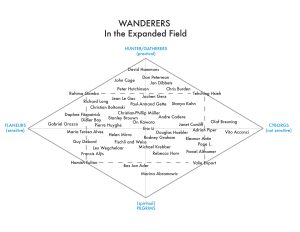Wanderers in the Expanded Field
2009: begun with Claire Bishop
2014: first published
2017: open sourced
01-16-2022: most recent update
This update adds two new incidents, one historical, one brand new. I recently had a vintage Dutch art museum magazine text translated, and in it was a passing conversation between curator Kasper König and a Dutch artist named Lex Wegchelaar. König had invited Wegchelaar to come to Antwerp and contribute to a project space he was running there. Wegchelaar said he couldn’t, unfortunately, because he would be making an artwork by walking the entire perimeter of Schiermonnikoop Island, off the north coast of The Netherlands, instead. A questionable entry, materially speaking, was just executed by Eric Li, who went for a walk across the internet for MoMA magazine. See the link at the bottom of this page.

At first glance, the diagram contained in Rosalind Krauss’ essay “Sculpture in the Expanded Field” doesn’t account for the artist’s body as a sculptural site. However, on closer examination the diagram would seem to posit all artists as sculptures, since their bodies are neither landscape nor architecture. If the artist’s body can explicitly be a site marker (Mendieta), a constructed site (Oiticica), or an axiomatic structure (Nauman), then the body of every artist must implicitly be a sculpture.
But what of the artist’s body in motion—of “going for a walk” as a work of art? Krauss cites photographic documents of walking in relation to the expanded field, but she makes no mention of what to do with the act of walking itself. Since an artist’s body can only ever be indoors or outdoors, she would seem to assume that it is always able to be located in her architecture/landscape dichotomy.
What interests us about this assumption is how the idea of wandering—that is, of going for a walk, allowing an element of chance to influence your movements, and deferring a final destination—introduces a degree of doubt into the diagram. To borrow from quantum physicist Werner Heisenberg, wandering artists embody a state of uncertainty. Stopping an artist from wandering in order to determine their location would destroy the essential character of their artwork, but as long as they continue walking the artwork remains incomplete.
Many artists who have gone for a walk and called it art over the last forty years have done so, in part, to experience this sense of forestallment, of indeterminacy. In that spirit, this diagram, originally devised with art historian Claire Bishop and subsequently updated with open source contributions, changes Krauss’s landscape/architecture antipodes to more interior, motivational points of reference, ones rooted in the artists’ sensitivity (or lack thereof) to the environment and what (if anything) they want from it. The perfect sculpture in our diagram, then, would be an artist who wanders forever without arriving anywhere or wanting anything.
Wanderers In The Expanded Field is a simple plotting of this potential. It contains all the artists that Claire and I could think of whose works, as acts of wandering, activate Krauss’s schematic in the same moment that they unravel it.
UPDATE: Since 2017 this diagram has been open sourced
UPDATE: Information added from On Walks and Travels, an exhibition and catalogue organized by Alexander Grevenstein for the Bonnefantemuseum, Maastricht, in 1979.
UPDATE: Information added from an article by Piet van Daalen, “From the Archives of A379089, Antwerp,” that appeared in Museumjournaal 174, Rotterdam, in 1973.
UPDATE: Eric Li, Taking a Walk Across the Internet, MoMA Magazine, 2022.
First published in Retracing the Expanded Field: Encounters between Art and Architecture, Spyros Papapetros and Julian Rose, eds., Cambridge: MIT Press, 2014.
For related content see Atmosphere